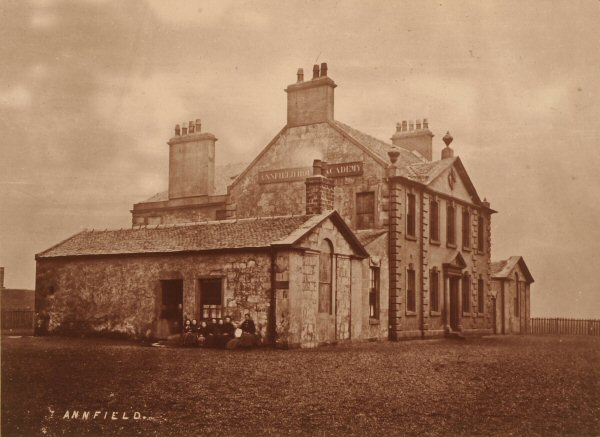

THIS property is situated about one mile eastward from the Cross, on the north side of the old highway to Edinburgh, now Eastern Gallowgate. It was once a beautiful suburban villa, embosomed in trees, and perfectly retired. But the unceasing extension of the City has reached that district, and completely changed its rural character. The grounds are now intersected by streets; both sides of the old highway built; and all that is at present recognizable of the Annfield of olden time is the house itself, yet lingering in a new street leading up to it from Gallowgate, but doomed to early demolition. The aspect, in a forlorn state, has been preserved in the photograph, and the following short sketch of its history may serve to show what the place was in former days:-
Anciently the grounds formed part of Over Gallowmuir. Their northern boundary was the old road from Drygate to Carntyne, now Eastern Duke Street; and on the west they were skirted by the track of one of the oldest thoroughfares around Glasgow, popularly known as "The Witch Lone," but subsequently widened, paved, and dignified by the somewhat Frenchified appellation of Bellegrove Street
As far back as 1666, in the reign of Charles II., the lands belonged to James Bogle, merchant in Glasgow. His son and his grandson, both of the same name, were proprietors in succession. The latter was the first secretary of the Royal Bank; and at the time of his death, in November, 1742, he was one of the directors. The only child of Secretary Bogle was a daughter named Charles, married to John Lockhart of Castlehill, Lanarkshire. She sold the property in 1750 to Robert Tennant, a person of considerable enterprise. Among other things, he built the first hotel proper in Glasgow, 115 years ago, still standing on the north side of Gallowgate, corner of Great Dovehill, and named by him "The Saracen's Head Inn." He was also one of the trustees for erecting the first Episcopalian Chapel in Glasgow, long popularly known as "The Whustlin' Kirk."
Tennant subsequently transferred the Gallowmuir acres to a wealthy tobacco merchant of the same surname, whose son, James, greatly improved them, converting, them into villa purposes. About 1770 he erected the mansion represented in the photograph, bestowing at same time upon the property the general appellation, "Annfield," in compliment to his wife, whose maiden name was Ann Park.
Annfield remained in the family of these Tennants till 1791, when it was sold to Mr. James Sword, sen., once a well known citizen, who still further improved it. Among other things, he built wings to the house, and made a large addition to it in rear.
He resided at Annfield about forty years. In his day it was a beautiful retreat. The mansion faces south, and stands near the north boundary. In front the grounds were laid off in ornamental shrubbery; stone walls, lined within by rows of old elm trees, skirted both highways, and nearly screened the house from public observation, while in rear of the mansion was a large walled garden, with hot-houses, bowling green, and other adjuncts. The avenue entered from the Edinburgh road, and ran along the west side of the property, with a handsome gateway, surmounted by figures of two lions, couchant, facing each other, and forming conspicuous roadside objects, many a day. (1)
Mr. Sword died at Annfield in December, 1832, and the property was soon after sold to Mr. John Reid, merchant in Glasgow, who did much to improve the eastern district, and acquired various other properties adjoining Annfield. Under his plans, Annfield was destined for feuing purposes, as a preliminary to which all the trees were cut down, the clay taken out, and the lawn converted into a brick-field. Latterly, lines of streets have been opened through the property, connecting Duke Street with Eastern Gallowgate, as well as transversely. In the midst of these operations, Mr. Reid died at Whitehill on 12th April, 1852, and the old Annfield mansion, with most of the unfeued ground, has since become the property of Alexander Dennistoun, Esq. of Golfhill, after whom the new suburb of "Dennistoun," in the immediate vicinity, is named. But "Sword Street" and "Annfield Street" will tend to preserve the remembrance of the hospitable old owner, and the appellation, as well as the locality, of his once beautiful residence, now shorn of all its attractions.
(1878.)
The house of Annfield was demolished in the spring of 1870. A large tenement of several storeys has since been built on the site, west side of the modern "Annfield Street," near the north or upper end. Mr. A. H. Dennistoun has now succeeded his father, the purchaser from Mr. Reid,
(1) In the course of local changes these leonine sculptures have undergone woeful mishap. Their heads have been knocked off, and their bodies are now doing duty on the entry to the Sub-dean Corn Mill in Ladywell Street, near the original lodge to the Necropolis.
Back to Contents